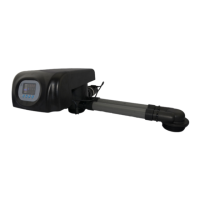MODEL F73(17603)
37
4. Softener fails
to draw brine.
A. Line pressure is too
low.
B. Brine line is plugged.
C. Brine line is leaking.
D. Injector is plugged.
E. Internal control leak.
F. Drain line is plugged.
G. Sizes of injector and
DLFC not match with
tank.
A. Increase line pressure.
B. Clean brine line.
C. Replace brine line.
D. Clean or replace injector.
E. Check valve body and change
if necessary.
F. Clean drain line flow control.
G. Select correct injector size and
DLFC according to the P20
requirements.
5. Unit used too
much salt.
A. Improper salt setting.
B. Excessive water in
brine tank.
A. Check salt usage and salt
setting.
B. See problem no.6.
6. Excessive
water in brine
tank.
A. Overlong refilling time.
B. Remain too much water
after brine.
C. Foreign material in brine
valve and plug drain line
flow control.
D. Not install safety brine
valve but power failure
whiling salting.
E. Safety brine valve
breakdown.
A. Reset correct refilling time.
B. Check the injector and make
sure no stuff in the brine pipe.
C. Clean brine valve and brine line.
D. Stop water supplying and restart
or install safety brine valve in salt
tank.
E. Repair or replace safety brine
valve.
7. Pressure
lost or rust in
pipe line.
A. Iron in the water supply
pipe.
B. Iron mass in the softener.
C. Fouled resin bed.
D. Too much iron in the raw
water.
A. Clean the water supply pipe.
B. Clean valve and add resin
cleaning chemical, increase
frequency of regeneration.
C. Check backwash, brine draw
and brine tank refill. Increase
frequency of regeneration and
backwash time.
D. Iron removal equipment is
required to install before softening.
8. Loss of
resin through
drain line.
A. Air in water system.
B. Bottom strainer broken.
C. Improperly sized drain
line control.
A. Assure that well system has
proper air eliminator control.
B. Replace new strainer.
C. Check for proper drain rate.

